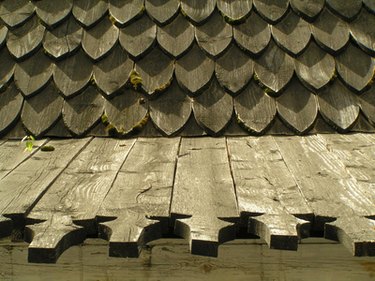Things You'll Need
Scraper
Sandpaper
Stiff bristled brush
Bucket

Cedar is commonly used for outdoor furniture, roofing and for shingles on the outside of a home. Painted shingles look great for the first two to three coats of paint. After years of being painted, exposed to the elements and painted again, the paint on cedar will begin to crack and peel. Removing the paint and restoring the cedar back to its original, bare wood finish will allow you to start fresh with either paint or stain and will enhance the look of the wood.
Step 1
Scrape away the peeling and cracking paint from the surface of the wood. Hold the scraper pointed away from your body. Work the blade of the scraper underneath the peeling paint and push away from you to remove the paint. Remove as much paint as you can with this method.
Video of the Day
Step 2
Sand the cedar with medium grit sandpaper. Remove all of the remaining surface paint with this method. Some paint may still be visible deep inside the grain of the wood. The sanding process should be sufficient depending on what finish you plan to apply to the cedar. A transparent stain will require you to remove all existing paint. If you plan to reapply paint, some residue can be left on the cedar.
Step 3
Scrub the cedar with a stiff bristled brush. Choose a brush made from natural or synthetic fibers but not metal. Brushing the cedar with a stiff bristled brush will release any trapped paint that has settled beneath the surface.
Step 4
Fill a large bucket with clean water. Rinse the wood thoroughly to remove all sanding and paint particles. Do not spray the cedar with a hose. High pressure spraying may damage the wood.
Step 5
Allow the cedar to dry completely. Then it will be ready for any type of treatment that you want to apply. Paint or stain will protect the wood from sun and water damage.
Video of the Day